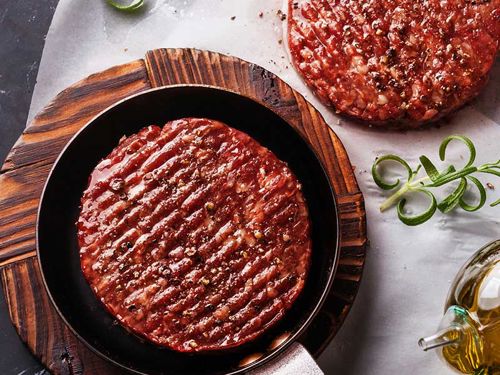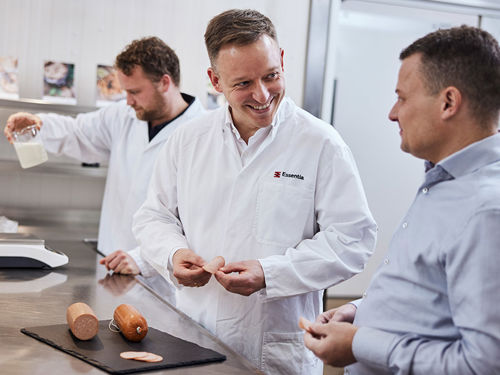Get some deeper insights on the importance of texture in various meat applications and explore the many advantages of using meat-based protein solutions for the enhancement of quality and yield in different processed meats, by viewing this interview with our applications expert Carsten Doktor.
Transcription of the video
"Today we will go over some of the techniques that helped improve texture in various meat products.
We have invited application specialist, Carsten Doktor to help us understand the advantages of using meat-based protein solutions for texture improvement.
Welcome Carsten, texture is an essential sensory attribute in meat as it has an important impact on the eating experience. But could you elaborate a bit of some of the additional advantages?
Yes, texture plays same very important role plays an important role for the consumers, and it plays some very important role for the industry, as well.
Looking at the consumers, we can talk about eating experience. We can talk about the bite, the immediate texture.
Also, the snapiness if we think about sausage, snapiness is very important. And for the industry, it could be sliceability. The stability in the productions and also spreadability will in some cases by an example, if you make a liver pâté, is spreadability very important.
For decades, Essentia has specialized in creating functional meat-based protein solutions that can either be mixed in or injected into various meat products in order to improve the texture. What functional features help improve the texture?
Well, most of our functional proteins are able to form a gel, some will gel during the heating process and some will gel when it is heated and then will be cooled down again. Depending on what functionality you want, we have for some proteins that gives you a soft gel. We have some that gives you a very firm and elastic gel. So, depending on what you want, we will have the right solution.
I know your proteins are derived from various animal sources. How does this impact the functionality and the texture?
You're right, Maja. Our proteins come from collagen based and blood-based animal raw material. They all have different attributes that make them fit into all the type of meat applications. So, we can help our customers in our innovations centers to get the desired texture.
You mentioned sliceability as one of the features related to texture. Could you help us understand why texture is important when it comes to producing sliced hams or sliced deli type products?
Yes. The texture of features is, of course, very important. The firmness is important. The cohesiveness is very important. And also the elasticity is very important. We have prepared this injected ham here, in our innovation center. And for the appearance point of view, you say it's very important that we have a uniform, product that we can slice very thin. So, the consumers will find this as a delicious ham in the shops.
And for the industry, it also has a big impact for the appearance and also for the economy and for the yield.
And mentioning the yield, we can talk about slicing yield. Slicing yield is very, very important because if we can help a manufacturer improving their slicing yield, we will also reduce the waste, which is money on the bottom line.
Not all meat products have to be sliced. And still, texture plays an important role in, let's say, meat balls, patties, and other ground meat products. What textural features are important when we talk about ground and minced meat product?
Yes, you're right. You say in the ground meat products, the functional proteins can help obtain the desired consistency. So, in this example where I have some fried meat balls, we could get the right, the right bite, the right texture, the right meaty texture in a product like this, when adding our functional ingredients.
Our functional ingredients will also help us maintain the right shape and the right size during the frying process.
And what about emulsified products like sausages and cold cuts?
Well, in emulsified meat products, like, it could be like sausages, as I have here. It is also about stabilizing the structure of the meat when you're processing or you are producing your sausages.
So, in products like this, we can rely on functional ingredients to help you stabilize the meat, obtain a good water binding, but also a good fat binding in the sausages.
Also, if we speak about fermented and dried products, it is also about to get the right bite, to get the tunness that we want in products like this fermented fuet and this fermented chorizo.
So, we can say that, all in all, will our ingredients help stabilizing the meat structure of all those products we see here and also other types of products.
Another relevant aspect about texture relates to the viscosity and spreadability of, for instance, a pâté. What features are important in spreadable applications?
Well Maya, in spreadable applications, like in the pâté also as you mentioned, it is, of course, very, very important that when we have a piece of bread like this and we want to spread the pâté that the texture is not too firm. It should not be too elastic because then we cannot spread it in a nice way.
But using the right ingredient, it will be very easy to spread it like you see here.
What happens to the texture when meat products are heated up during cooking or frying?
Well, depending on which of our proteins you're using, there will be ... a different thing will happen. We have proteins, like our plasma that is heat stable. Our collagen-based products are thermo reversible. So, if you use them, it will actually become more soft and then it will set as a gel when you cool it down again.
We also have products that, as I will call it, heat tolerant. So, it's not stable, but it is more heat tolerant. So, that's something in between firm reversible and heat stable. So, we have different proteins depending of the application that you would like to make.
I hope this help you get a better picture of how functional proteins can help you improve the texture in almost any type of meat products.
What we learned today is that the gel forming properties of functional proteins are essential for texture improvement in meat products.
We also learned that text improvement can be translated into improved sliceability, improved stability, improved eating experience and improved spreadability.
Join us again soon where we will take a deep dive into another challenge within the food and meat processing industry."




